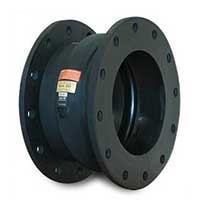
Single Wide Arch Expansion Joint (231)
STYLE
231/221
single wide arch spool type
rubber expansion joints
single wide arch spool type
rubber expansion joints
single wide arch spool typerubber expansion joints
Definition — A control unit assembly is a system of two or more control rod units (limit rods, tie rods or compression sleeves) placed across an expansion joint from flange to flange to minimize possible damage caused by excessive motion of a pipeline. The failure of an anchor or some other piece of equipment in a pipeline can cause excessive motion. The control unit assemblies can be set at the maximum allowable expansion and/or contraction of the rubber expansion joint. When used in this manner, control units are an additional safety factor and can minimize possible damage to adjacent equipment.
Use of Control Units with Rubber Expansion Joints Rubber expansion joints must be installed between two fixed anchor points in a piping system. The pipe system must be rigidly anchored on both sides of the expansion joint to control expansion or contraction of the line. Piping anchors must be capable of withstanding the line thrusts generated by internal pressure or wide temperature fluctuations. When proper anchoring cannot be provided, CONTROL UNITS ARE REQUIRED.
Listed below are three (3) control unit configurations supplied by PROCO and are commonly used with rubber expansion joints in piping systems.
Figure 1 — Known as a “LIMIT ROD”, this control unit configuration will allow an expansion joint to extend to a predetermined extension setting. Nuts shall be field set to no more than the maximum allowable extension movement of a
rubber expansion joint. Refer to Tables 2, 3, or 4 in this manual. Consult the systems engineer for proper nut settings prior to system operation.
Figure 2 — Known as a “CONTROL ROD”, this control unit configuration is used to allow specified pipe expansion (expansion joint axial compression) and pipe contraction (expansion joint axial extension) movements. Nuts shall be
field set to no more than the maximum allowable extension or compression of a rubber expansion joint. Refer to Tables 2, 3 or 4 in this Manual.
Internal and external nuts can also be field set to allow for no movement in the horizontal plane. This setting will allow the rubber to move laterally while keeping expansion joint thrust forces low on adjacent equipment. Spherical washers can also be furnished (upon request) to combat any potential “nut to plate” binding during offset. Consult the systems engineer for proper nut settings prior to system operation.
Figure 3 — Known as a “COMPRESSION SLEEVE”, this configuration is used to allow for specified pipe expansion (expansion joint axial compression) and pipe contraction (expansion joint extension) movements. Nuts shall be field set
to no more than the maximum allowable extension of a rubber expansion joint. Refer to Tables 2, 3, or 4 in this manual. PROCO will manufacture each compression sleeve to allow for no axial movement unless otherwise specified by the purchaser. Compression sleeves shall be field trimmed to meet required allowable axial movement as set forth by system requirements. Spherical washers
can also be furnished (upon request) to combat any potential “nut to plate” binding during offset. Consult the systems engineer for proper sleeve lengths prior to system operation.
Important Control Rod Considerations — The number of rods, control rod diameters and control rod plate thicknesses are important considerations when specifying control units for an application. As a minimum, specifying engineers or purchasers shall follow the guidelines as set forth in Appendix C of the Fluid Sealing Association’s Rubber Expansion Joint Division Technical Handbook (Sixth Edition). PROCO engineers its control unit assemblies to system requirements.
Our designs incorporate an allowable stress of 65% of material yield for each rod and plate (rod and plate material to be specified by purchaser). Therefore, it is important to provide pressure and temperature ratings to PROCO when requesting control units for rubber expansion joints. It is also important to provide adjacent mating flange thickness or mating specifications to insure correct rod lengths are provided.
